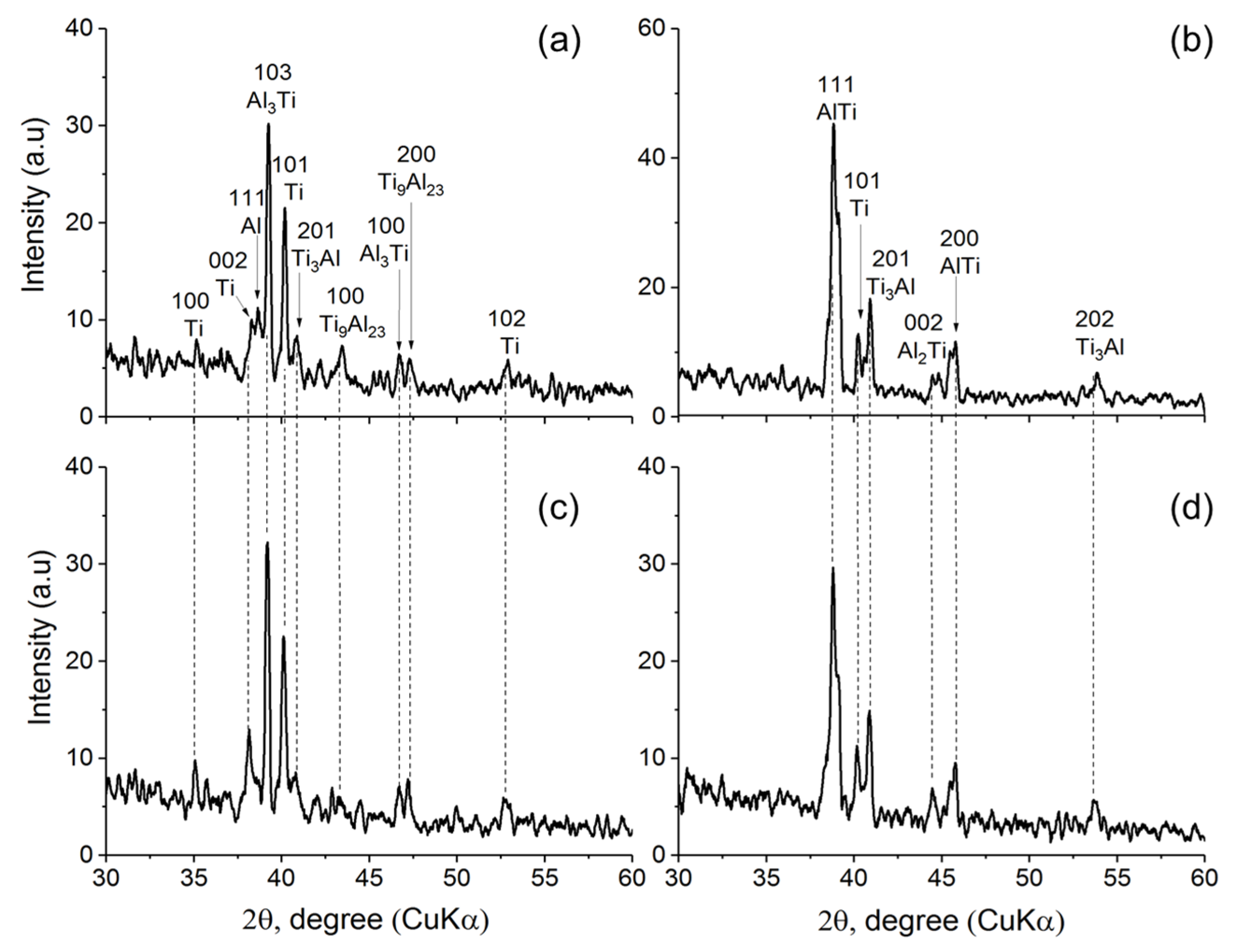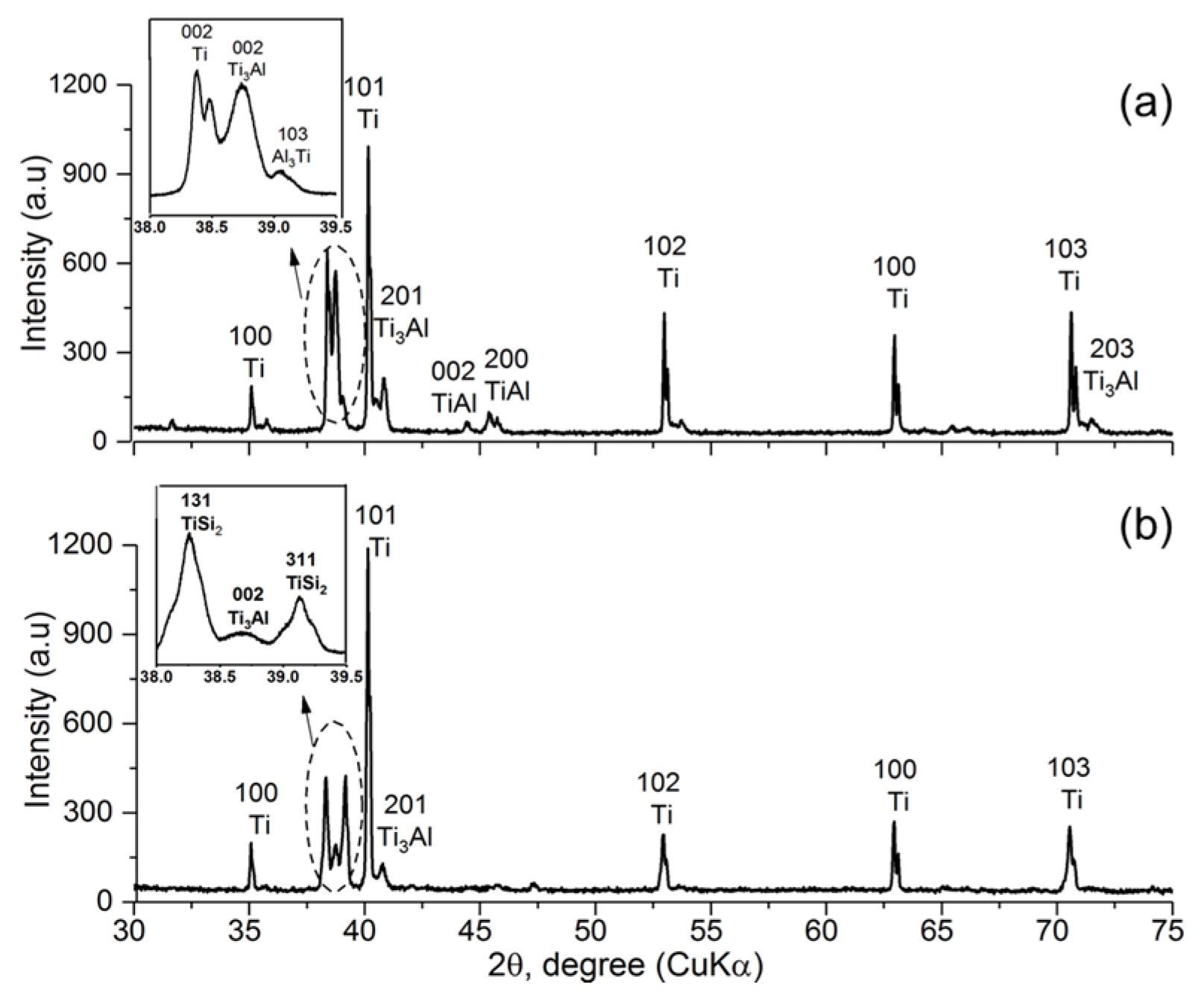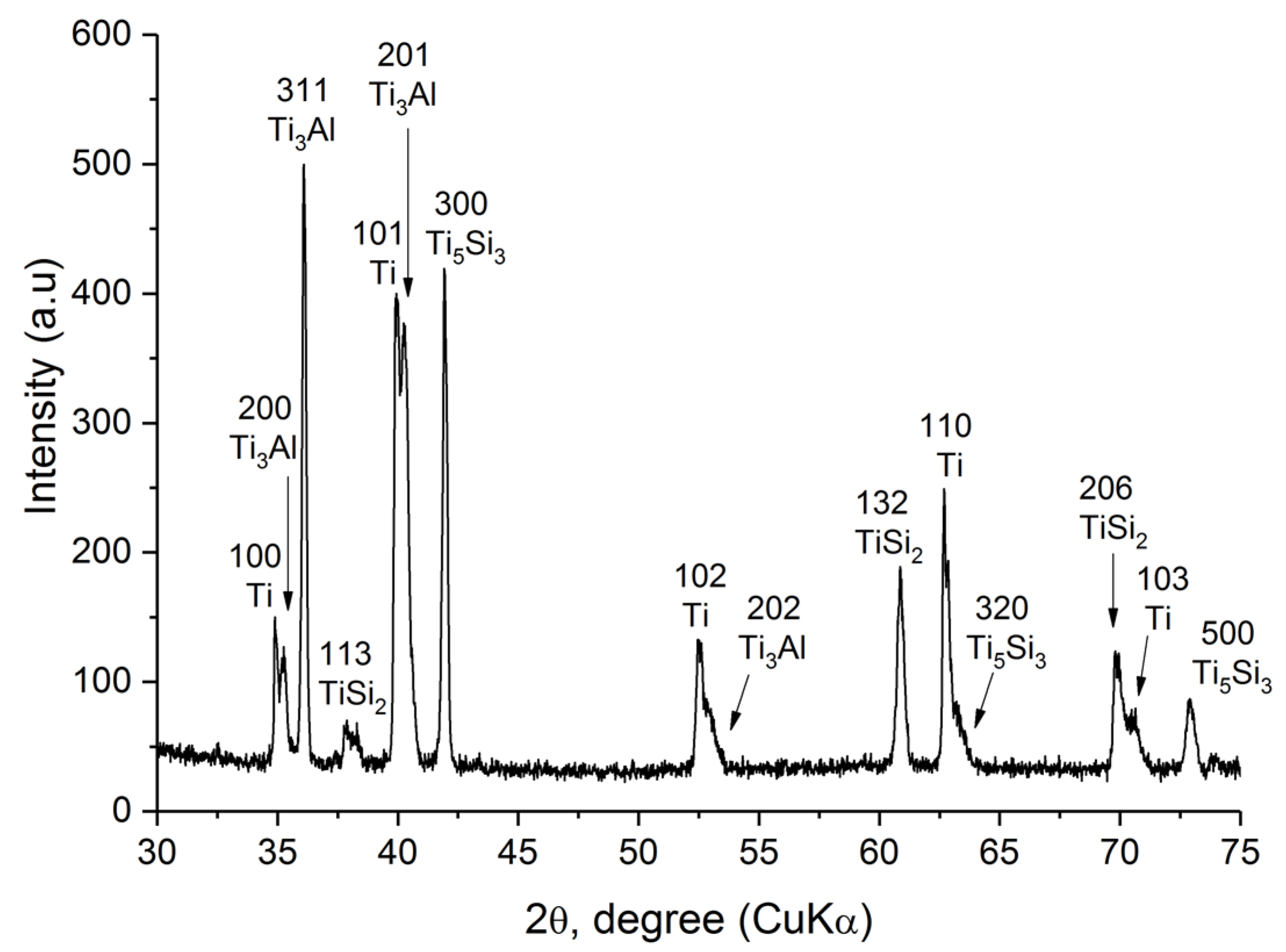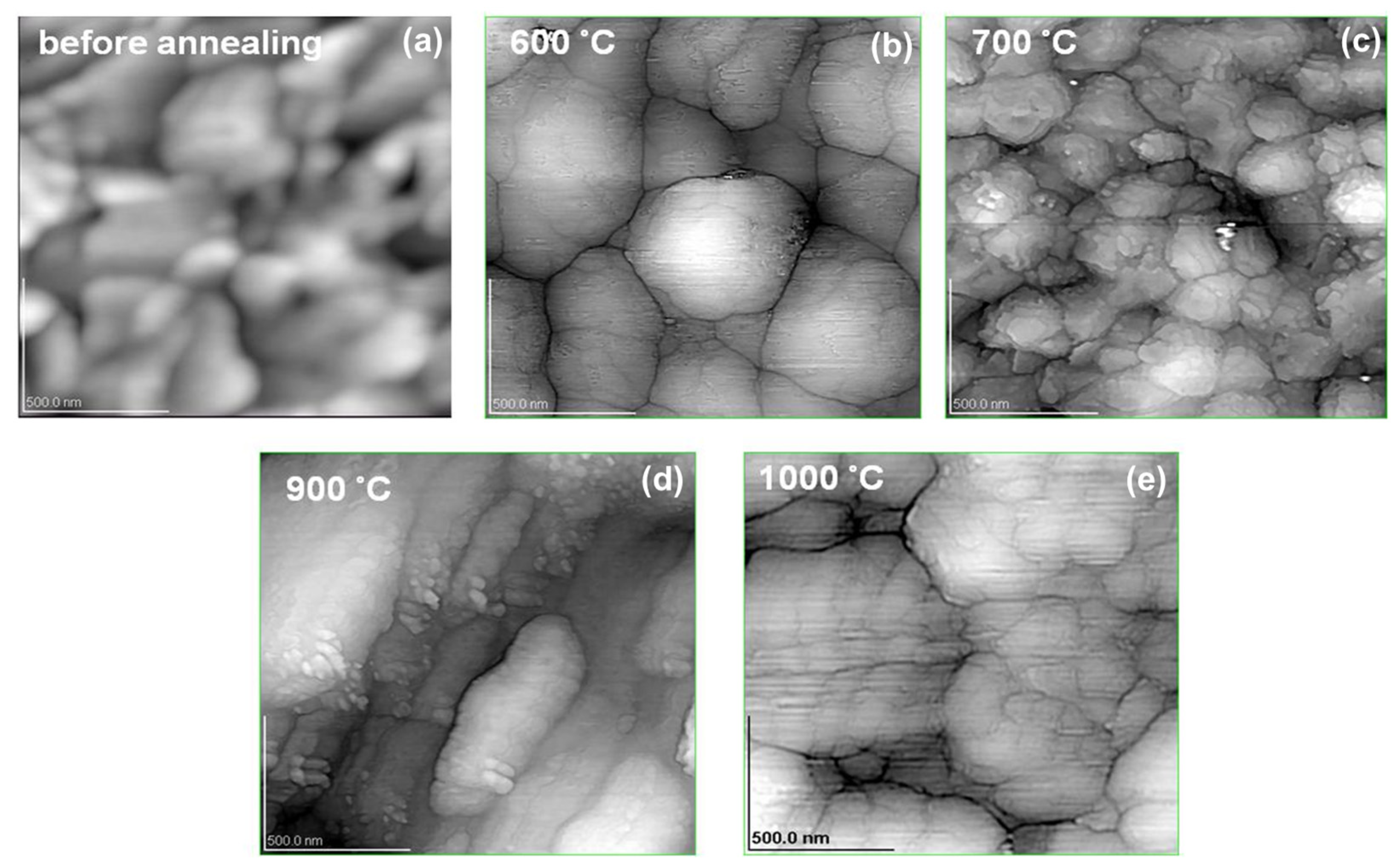Effect of Irradiation with Si+ Ions on Phase Transformations in Ti–Al System during Thermal Annealing
Abstract
1. Introduction
2. Materials and Methods
3. Results and Discussion
4. Conclusions
Author Contributions
Funding
Institutional Review Board Statement
Informed Consent Statement
Data Availability Statement
Acknowledgments
Conflicts of Interest
References
- Braun, J.; Ellner, M. Phase Equilibria Investigations on the Aluminum-Rich Part of the Binary System Ti-Al. Metall. Mater. Trans. A Phys. Metall. Mater. Sci. 2001, 32, 1037–1047. [Google Scholar] [CrossRef]
- Kim, Y.W. Ordered Intermetallic Alloys, Part III: Gamma Titanium Aluminides. JOM J. Miner. Met. Mater. Soc. 1994, 46, 30–39. [Google Scholar] [CrossRef]
- Lasalmonie, A. Intermetallics: Why is it so Difficult to Introduce them in Gas Turbine Engines. Intermetallics 2006, 14, 1123–1129. [Google Scholar] [CrossRef]
- Karkina, L.E.; Yakovenkova, L.I.; Rabovskaya, M.Y. Computer Simulation of Ti3Al Intermetallic Cleavage Fracture. Tech. Phys. 2006, 5, 342–348. [Google Scholar] [CrossRef]
- Li, X.T.; Huang, L.J.; Jiang, S.; Gao, Y.N.; An, Q.; Wang, S.; Zhang, R.; Geng, L. Microstructure and Super Oxidation Resistance of the Network Structured Ti-Al-Si Coating. J. Alloy. Compd. 2019, 807, 151679. [Google Scholar] [CrossRef]
- Jia, Q.; Li, D.; Li, S.; Zhang, Z.; Zhang, N. High-Temperature Oxidation Resistance of NiAl Intermetallic Formed In Situ by Thermal Spraying. Coatings 2018, 8, 292. [Google Scholar] [CrossRef]
- Lee, J.-H.; Yun, J.-G.; Kwak, S.-Y.; Kang, C.-Y. Nucleation and Growth of Intermetallic Compounds Formed in Boron Steel Hot-Dipped in Al–Ni Alloy. Coatings 2017, 7, 195. [Google Scholar] [CrossRef]
- Tulenbergenov, T.; Skakov, M.; Kolodeshnikov, A.; Zuev, V.; Rakhadilov, B.; Sokolov, I.; Ganovichev, D.; Miniyazov, A.; Bukina, O. Interaction between Nitrogen Plasma and Tungsten. Nucl. Mater. Energy 2017, 13, 63–67. [Google Scholar] [CrossRef]
- Stepanov, A.L.; Nuzhdin, V.I.; Valeev, V.F.; Vorobev, V.V.; Rogov, A.M.; Osin, Y.N. Study of silicon surface implanted by silver ions. Vacuum 2019, 159, 353–357. [Google Scholar] [CrossRef]
- Feng, K.; Cai, X.; Li, Z.; Chu, P.K. Improved corrosion resistance of stainless steel 316L by Ti ion implantation. Mater. Lett. 2012, 68, 450–452. [Google Scholar] [CrossRef]
- Deng, B.; Pei, J.F.; Tao, Y. Microstructure, Mechanical and Tribological Properties of the TiAlN Coatings AfterNb and C Dual Ion Implantation. Mater. Sci. Forum 2014, 789, 455–460. [Google Scholar] [CrossRef]
- Deng, B.; Tao, Y.; Hu, Z. The Microstructure, Mechanical and Tribological Properties of TiN Coatings AfterNb and C Ion Implantation. Appl. Surf. Sci. 2013, 284, 405–411. [Google Scholar] [CrossRef]
- Nikonenko, A.V.; Popova, N.A.; Nikonenko, E.L.; Kurzina, I.A. The effect of aluminum ion implantation on the grain size and structure of UFG titanium. Surf. Coat. Technol. 2020, 393, 125750. [Google Scholar] [CrossRef]
- Romankov, S.; Park, Y.C.; Shchetinin, I.V. Structural transformations in (CoFeNi)/Ti nanocomposite systems during prolonged heating. J. Alloy. Compd. 2018, 745, 44–54. [Google Scholar] [CrossRef]
- Pflüger, M.; Soltwisch, V.; Probst, J.; Scholze, F.; Krumrey, M. Grazing-incidence small-angle X-ray scattering (GISAXS) on small periodic targets using large beams. IUCrJ 2017, 5, 431–438. [Google Scholar] [CrossRef] [PubMed]
- Bernhard, N.; Burkel, E.; Gompper, G.; Metzger, H.; Peisl, J.; Wagner, H.; Wallner, G. Grazing incidence diffraction of X-rays at a Si single crystal surface: Comparison of theory and experiment. Z. B Condens. Matter 1987, 69, 303–311. [Google Scholar] [CrossRef]
- Sagdoldina, Z.; Rakhadilov, B.; Kenesbekov, A.; Stepanova, O.; Buitkenov, D. Phase-structural Condition of the Ti-Al System Treated by Irradiation with Si Ions and Heat Treatment. In Proceedings of the 2019 IEEE 9th International Conference Nanomaterials: Applications & Properties (NAP), Odesa, Ukraine, 15–20 September 2019. [Google Scholar] [CrossRef]
- Rahadilov, B.K.; Skakov, M.K.; Tulenbergenov, T.R. Tungsten Surface Erosion by Hydrogen Plasma Irradiation. Key Eng. Mater. 2017, 736, 46–51. [Google Scholar] [CrossRef]
- Wang, H.; Zha, M.; Lü, S.; Wang, C.; Jiang, Q. Reaction pathway and phase transitions in Al–Ti–Si system during differential thermal analysis. Solid State Sci. 2010, 12, 1347–1351. [Google Scholar] [CrossRef]
- Vojtěch, D.; Čížová, H.; Maixner, J. Some aspects of the high-temperature behaviour of an in situ Ti-Ti5Si3 eutectic composite. Kov. Mater 2005, 43, 317–337. [Google Scholar]





| Absorber | Cu-Kα Radiation | ||||||
|---|---|---|---|---|---|---|---|
| Ti | φ, degrees | 0.5 | 1.0 | 1.5 | 2.0 | 2.5 | 3.0 |
| x(m), μm | 0.44 | 0.87 | 1.31 | 1.74 | 2.18 | 2.61 | |
| x(e), μm | 0.09 | 0.19 | 0.28 | 0.38 | 0.47 | 0.57 | |
| Sample | Crystallite Size, D (A) | Microdistortion, ∆d/d | ||
|---|---|---|---|---|
| Before Si+ Implantation | After Si+ Implantation | Before Si+ Implantation | After Si+ Implantation | |
| Al film with the Ti substrate | 491 | 911 | 0.00283 | 0.00064 |
| Sample | Crystallite Size, D (A) | Microdistortion, ∆d/d | ||
|---|---|---|---|---|
| Before Si+ Implantation | After Si+ Implantation | Before Si+ Implantation | After Si+ Implantation | |
| Al film with the Ti substrate | 498 | 422 | 0.00334 | 0.00289 |
Publisher’s Note: MDPI stays neutral with regard to jurisdictional claims in published maps and institutional affiliations. |
© 2021 by the authors. Licensee MDPI, Basel, Switzerland. This article is an open access article distributed under the terms and conditions of the Creative Commons Attribution (CC BY) license (http://creativecommons.org/licenses/by/4.0/).
Share and Cite
Sagdoldina, Z.; Rakhadilov, B.; Kurbanbekov, S.; Kozhanova, R.; Kengesbekov, A. Effect of Irradiation with Si+ Ions on Phase Transformations in Ti–Al System during Thermal Annealing. Coatings 2021, 11, 205. https://doi.org/10.3390/coatings11020205
Sagdoldina Z, Rakhadilov B, Kurbanbekov S, Kozhanova R, Kengesbekov A. Effect of Irradiation with Si+ Ions on Phase Transformations in Ti–Al System during Thermal Annealing. Coatings. 2021; 11(2):205. https://doi.org/10.3390/coatings11020205
Chicago/Turabian StyleSagdoldina, Zhuldyz, Bauyrzhan Rakhadilov, Sherzod Kurbanbekov, Rauan Kozhanova, and Aidar Kengesbekov. 2021. "Effect of Irradiation with Si+ Ions on Phase Transformations in Ti–Al System during Thermal Annealing" Coatings 11, no. 2: 205. https://doi.org/10.3390/coatings11020205
APA StyleSagdoldina, Z., Rakhadilov, B., Kurbanbekov, S., Kozhanova, R., & Kengesbekov, A. (2021). Effect of Irradiation with Si+ Ions on Phase Transformations in Ti–Al System during Thermal Annealing. Coatings, 11(2), 205. https://doi.org/10.3390/coatings11020205






